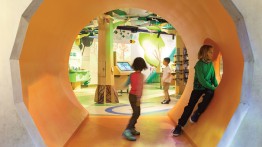COOPERMADE: Exhibition & Building Design

SKOLNICK Architecture + Design Partnership has designed myriad buildings and exhibitions for a wide range of uses, but the firm’s portfolio is particularly weighted towards projects that privilege education and culture. The firm, which was founded in 1980 by Cooper architecture graduate Lee Skolnick AR'79, has created a tremendous number of exciting and inventive museum spaces and visitor experiences. Paul Alter AR'82, a fellow Cooper architecture graduate, joined the firm several years later and soon became a Principal and Partner.
SKOLNICK’s work geared towards children and families has included exhibitions for the Miami Children’s Museum where they designed all the Museum’s inaugural exhibits and ten years later were invited back to provide Interpretive Master Planning services for 14 exhibit upgrades. Their design approach for this project was informed by what’s known as the Reggio Emilia Approach, a pedagogy that stresses exploration and collaboration to encourage creative problem solving. With an emphasis on STEAM education, the updated exhibits are immersive environments with hands-on activities that cover topics such as health and wellness, art and music, physical science, and nature.
SKOLNICK has worked on multiple projects in Bulgaria, including providing innovative architectural, graphic, and exhibit design services for the country’s first children’s museum, Muzeiko. Opened in 2015, the museum, which is located in Sofia, is designed to give Bulgarian children greater access to informal educational opportunities. Unlike many of the country’s museums that tend towards more monumental, Neoclassical or Soviet Brutalist architecture, Muzeiko’s modern design uses glass to communicate openness and transparency and encourage visitors to explore. The design sets out to reflect Bulgaria’s history and topography with its glass-framed structure punctuated by three faceted volumes that refer to the nation’s mountainous terrain. These three “little mountains” use color, pattern, and form to connote Bulgarian crafts in the fields of textiles, ceramics, and wood carvings. Commissioned by the America for Bulgaria Foundation, and done in collaboration with A&A Architects, Sofia, Muzeiko includes three floors of interactive exhibits, a science playground, green roof, rain garden, a rooftop climbing wall, and an amphitheater.
In Bulgaria’s second largest city, Plovdiv—also known as the ancient capital city of Philippopolis—SKOLNICK recently planned an interpretive strategy and designed exhibits for the visitor’s center of the Bishop’s Basilica, a site occupied since antiquity and housing Roman mosaics from the 4th to 6th centuries. An important historical site for the world and Bulgarian heritage, the basilica’s mosaics depict flora and fauna as well as iconography of early Christian life. SKOLNICK was tasked with designing a multi-faceted visitor experience that would appeal both to local audiences and international visitors. They created a host of interactive exhibits that let viewers experience the site as an archaeologist would, but at the same time, by shaping spaces and framing views using various structural elements such as a caracol ramp and parts of a geodesic dome, the team created an inviting platform both physical and pedagogical to understand the mosaics and the lives of the artisans that made them. The new visitor’s center opened to the public last April and is presently a nominee for designation as a UNESCO World Heritage site.





